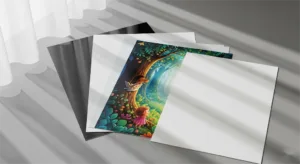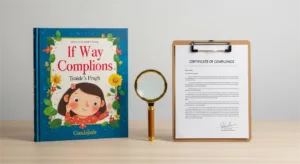Are you an indie author wrestling with cover design costs? You know a killer cover is crucial for grabbing readers, but figuring out how much to spend – and where to spend it – can feel overwhelming. This guide cuts through the noise and gives you the exact breakdown you need.
Book cover design costs in the US range from free (DIY with tools like Canva) to over $3,000 for a top-tier design agency. A realistic budget for a professional, custom-designed cover from a freelance designer is $300-$800. Factors impacting price include designer experience, design complexity (custom illustration vs. stock photos), and the number of revisions. Pre-made covers offer a budget-friendly alternative, typically costing between $100 and $450.
This is just the tip of the iceberg. Inside, you’ll discover how to match your cover to your genre, communicate effectively with designers, and even test different designs to maximize your sales – all while keeping your budget in check. In short, maximize ROI without sacrificing quality.
Why Your Book Cover is More Than Just a Pretty Picture

You might think of your cover as simply an attractive image, but it’s so much more. It’s your book’s primary marketing tool. It is the silent salesperson. It’s working for you 24/7, online and (eventually, hopefully!) in bookstores.
The Psychology of First Impressions
Think about how quickly you judge something – a person, a website, a product. It’s almost instantaneous, isn’t it? Readers are the same. They’ll form an opinion about your book in mere seconds, based almost entirely on the cover. Studies show that color alone can influence up to 85% of a consumer’s purchasing decision. Your cover needs to convey the genre, tone, and overall quality of your book almost instantly. Understanding genre conventions in book cover design is crucial for achieving this.
As David Gaughran, author of Let’s Get Digital, puts it, “A great cover is not just about aesthetics; it’s about signaling genre, tone, and professionalism. It’s a silent salesperson for your book.” He’s absolutely right. It’s not just art; it’s communication.
The Cover as a Marketing Investment (ROI)
Let’s talk numbers. Think of your cover design as an investment, and like any good investment, you want a solid return. A well-designed cover leads to higher click-through rates (CTR) on online platforms like Amazon. This translates to more people viewing your book’s details, which leads to more sales, and ultimately, more revenue.
Consider this: Books with professionally designed covers enjoy, on average, a 34% higher sales rate than those without. And when a book’s cover is redesigned? Click-through rates can jump by 51%, and in some cases, even as high as 122%!
Decoding Book Cover Design Costs
Table Title: Book Cover Design Cost Comparison
| Design Option | Price Range (USD) | Pros | Cons | Best For |
| DIY | $0 – $262 | Full control, lowest cost. | Requires design skills, time-consuming, risk of unprofessional look. |
Authors with design experience or extremely limited budgets.
|
| Pre-Made Covers | $100 – $450 | Affordable, professional quality, fast turnaround. | Limited customization, potential for less uniqueness. |
Authors needing a quick, budget-friendly, genre-appropriate cover.
|
| Freelance Designer | $50 – $500+ | Customizable, range of experience levels and pricing. | Quality varies, requires careful vetting, communication is key. |
Authors seeking a custom design with a moderate budget.
|
| Design Agency/Company | $300 – $3000+ | Highest quality, professional service, branding & marketing expertise. | Most expensive, longer timelines, potentially less direct control. |
Authors prioritizing top-tier design and/or requiring extensive services.
|
| Getcovers.com | $10-$35 | Affordable, Unlimited free revisions | Entry-level designers |
Authors extremely limited budgets
|
Now, let’s get down to the practicalities – the actual cost. You’ll find a wide range of options, and understanding the factors that influence price is key to making the right choice for your budget and your book. To help with your overall strategy, be sure to also check out a Book Pricing Strategy.
The Price Range: From DIY to Designer Agencies
The cost of a book cover can range from completely free (if you’re doing it yourself) to thousands of dollars for a top-tier design agency. Let’s break down the most common options:
DIY Design (0 – $262)
If you have some design skills and are on a very tight budget, this might be tempting. Tools like Canva offer free templates and design elements. However, be aware of the limitations. Paid software like Adobe Photoshop starts at $22.99 per month, and stock photos from sites like Shutterstock will add to your costs (around $29+ per month).
A Quick Canva Tip: Use pre-designed templates, but always customize the font and colors. This will help you avoid that “cookie-cutter” look that screams “amateur.” Remember: While DIY can save money upfront, it’s crucial to be honest about your skills. A poorly designed cover can actively harm your book’s chances.
Pre-Made Covers ($100 – $450)
These are pre-designed covers that you can purchase and then have customized with your book’s title and author name. Platforms like Getcovers, and SelfPubBookCovers offer a wide selection. Getcovers offers particularly affordable pre-made options, with some as low as $10, with higher-quality premades between $250-$450. This is a good middle ground, offering a professional look without the full custom design price tag.
Freelance Designers ($50 – $500+)
This is where you’ll find the biggest price variation. A beginner designer on a platform like Fiverr might charge as little as $20-$100. However, for an experienced, professional freelance designer specializing in book covers (found on sites like Reedsy or Upwork), expect to pay anywhere from $300 to $500, or even more, depending on their experience and the complexity of the design.
Design Agencies/Companies ($300 – $3000+)
These companies offer a full range of services, often including custom illustration, marketing consultation, and even branding packages. Some well-known names include Ebook Launch (ebook covers starting at $497, ebook + print at $595), Damonza (standard covers from $645, premium up to $1645), MiblArt (ebook and print for $200, premium at $700), and 99designs (ranging from $279-$999). While this is the most expensive option, it provides the highest level of quality and service.
Factors Influencing Cover Design Cost
Several key factors that will impact the final price of that cover:
- Designer Experience/Reputation: Like any profession, experience comes at a premium.
- Design Complexity: A simple, text-based cover will be cheaper than one requiring intricate illustrations or 3D rendering.
- Custom Illustration vs. Stock Photos: Custom art is significantly more expensive than using stock images.
- Number of Revisions: Most designers include a limited number of revisions in their price. Going beyond that limit will usually incur extra fees.
- Genre: Some Genre, like Fantasy or Sci-fi can be more, due to demand and detail.
- Special Effects: If you’re envisioning special print effects like foil stamping or embossing, those will add to the printing cost (a subtle reminder that Mainland Printing can help with that stage!).
- Turnaround Time: Need it fast? Expect to pay a rush fee. It is important to always get clear pricing before agreeing to any work.
If you are also thinking about printing, be sure to learn What Impact Book Printing Prices? Key Factors Explained.
Matching Your Book Cover Design to Your Genre and Audience

A beautiful cover that doesn’t fit your book’s genre is like a beautiful dress worn to the wrong occasion – it just won’t work. Understanding genre conventions is crucial for attracting the right readers.
Understanding Genre Conventions
Readers have expectations. They browse books by genre, and your cover needs to instantly signal what kind of story they can expect. This isn’t about being unoriginal; it’s about speaking the visual language of your target audience.
Fiction Genres:
- Romance: Think soft colors, often pastels. Images of attractive couples are common, and fonts tend to be flowing or script-like.
- Thriller/Mystery: Darker color palettes dominate, often with a single, suspenseful image. Bold, impactful fonts are key.
- Sci-Fi/Fantasy: These covers often feature detailed illustrations of otherworldly settings, creatures, or characters. Unique, sometimes custom-designed typography is common.
- Historical Fiction: The imagery should reflect the specific historical period. Fonts tend to be more classic and traditional.
Non-Fiction Genres:
- Business/Self-Help: These covers often feature clean, uncluttered designs. Bold titles and author photos are frequently used to establish authority.
- Memoir/Biography: A compelling portrait of the subject is common, often paired with evocative imagery related to their life story.
- Cookbooks: High-quality, mouth-watering food photography is essential!
Knowing Your Target Reader
Beyond genre, think deeply about who you’re writing for. Creating a detailed reader persona can significantly impact your design choices. A young adult fantasy novel will have a very different cover aesthetic than a literary fiction novel aimed at an older, more sophisticated audience. Consider creating a reader persona: age, gender, interests, even their favorite websites or magazines. This will help you (and your designer) make informed choices about the cover’s look and feel.
The “Visual Language” of Book Covers
The visual elements should create an emotional response.
- Color Psychology: Colors evoke emotions. Red can signify passion or danger, while blue often conveys trust and calmness. High contrast covers tend to get the most attention.
- Font Psychology: Serif fonts (like Times New Roman) feel traditional and established. Sans-serif fonts (like Helvetica) are more modern. Script fonts can convey elegance or romance.
- Layout: Most people read from left to right and top to bottom. This is known as the Z-Pattern, and most covers are designed with this in mind. Take, for example, the fantasy novel covers designed by MiblArt. They often feature intricate illustrations, dramatic lighting, and bold, expressive fonts – all elements that instantly signal “fantasy” to a potential reader. This is crucial in a crowded market like the US, where readers make snap judgments based on genre expectations. This is where an investment, even a modest one of $200, can make a difference.
The Design Process: A Step-by-Step Guide

Knowing what to expect during the design process can save you time, money, and frustration. Whether you choose to DIY, use a pre-made cover, or hire a professional, a clear process is essential.
Finding and Choosing the Right Designer (or Choosing DIY)
We’ve already discussed the pros and cons of each option. If you decide to hire a freelancer, thoroughly review their portfolio, looking specifically for work in your genre. Read client testimonials to gauge their professionalism and communication style. Don’t be afraid to ask questions:
- What’s your experience designing covers for [your genre]?:
- Can you walk me through your design process?:
- How many revisions are included in your price?:
- What file formats will you provide?:
Creating a Compelling Design Brief
A design brief is your roadmap. It’s how you communicate your vision to the designer (or to yourself, if you’re DIYing). A good brief prevents misunderstandings and ensures you get the cover you want. Essential elements of a brief include:
- Your book’s title and subtitle:
- Your author name:
- A concise summary of your book (the blurb):
- A clear description of your target audience:
- The genre and subgenre of your book:
- The overall tone and mood you want to convey (e.g., dark and suspenseful, light and romantic):
- Examples of covers you like and, importantly, covers you dislike (and why):
- Any specific imagery or elements you have in mind:
- Technical specifications (e.g., ebook only, print dimensions):
Communicating Effectively with Your Designer
Good communication is a two-way street. Provide constructive feedback. Instead of saying “I don’t like it,” explain why. For example, “The font feels too modern for my historical setting. Could we try something more classic, like a serif font?” Be specific, and always be respectful of the designer’s expertise. They may have valuable insights you haven’t considered. Remember the best result comes from a collaboration. The best designers are not mere executors, but advisors.
Understanding Copyright and Licensing
This is crucial. You must ensure that any images or fonts used on your cover are legally licensed for commercial use. Don’t just grab images from Google! Reputable stock photo sites like Shutterstock or Depositphotos offer royalty-free images.
Finalizing and Receiving Your Files
Once you’re happy with the design, you’ll need the correct files. For an ebook, you’ll typically need a high-resolution JPEG. For print, you’ll need a PDF/X-1a file, formatted to your printer’s specifications. It’s also wise to request the source files (layered Photoshop or Illustrator files) in case you need to make changes in the future. By treating your designer as a strategic partner, rather than just someone who executes your instructions, also make sure you prepare your Book Files for Printing.
Maximizing Your Cover’s Impact: Testing and Optimization
Even with the best design, there’s always room for improvement. Testing different cover variations can reveal valuable insights and help you maximize your book’s potential.
The Importance of A/B Testing
A/B testing, also known as split testing, involves showing different versions of your cover to different groups of people and tracking which version performs better. This is how you move beyond guesswork and make data-driven decisions.
Low-Cost Testing Methods
You don’t need a huge budget to test your cover. Here are some simple, effective methods:
- Social Media Polls: Create polls on Facebook or Twitter, asking your followers which cover they prefer.
- Facebook/Amazon Ads: Run small, targeted ad campaigns with different cover variations. Even a $5 budget can provide valuable data.
- PickFu: This platform allows you to get feedback from your target audience on different design options.
Tracking Your Results
The key to A/B testing is tracking the right metrics. Focus on:
- Click-Through Rates (CTR): On platforms like Amazon, track how many people click on your book listing after seeing your cover.
- Sales: Ultimately, the most important metric is sales. Monitor your sales figures before and after making any cover changes.
- Publisher Rocket is a great, low cost option:
Conclusion
Your book cover is far more than just a pretty picture; it’s a crucial investment in your book’s success. It’s the first impression, the silent salesperson, and a key component of your author brand. By understanding the costs involved, carefully considering your genre and target audience, and embracing a strategic, data-driven approach, you can create a cover that not only attracts readers but also converts them into buyers.
And, when you’re ready to turn your manuscript and stunning cover into a beautifully printed book, you can always contact a company like Mainland Printing. We can help bring the physical manifestation to life.







